Table of Contents
ISC Class 12 Economics Answer Key 2024
The Council of Indian School Certificate Examinations (CISCE) conducted the ISC Class 12 Economics 2024 Examination on February 23rd February, 2024. The class 12 School Certificate exam is given once a year. The Class 12 Economics Paper 2024 concluded at 5 p.m. The ISC Economics Question Paper 2024 and ISC Class 12 Economics Answer Key 2024 PDF Download Link are provided here. Also, review some important economics questions below, which you can use as an ISC Economics 12th Suggestion 2024 for the next years exam.
ISC Economics Answer Key 2024
The ISC Economics answer key 2024 includes the correct answers to all questions. The ISC Class 12 Economics Question Paper 2024 (theory paper) carries a total of 80 marks. The Class 12th Economics syllabus also includes a 20-mark project work. The exams last three hours and are set for 2 to 5 p.m. Students were given another 15 minutes to read the paper. Check out the ISC Economics questions and answers 2024 information down below.
| Class 12 Economics Question Paper 2024 ISC | |
| Name of Examination | Indian School Certificate Exam |
| Exam Conducting Body | Council for the Indian School Certificate Examinations |
| Category | ISC Economics Answer Key 2024 |
| Session | 2023-24 |
| Unofficial ISC Economics Answer Key 2024 Class 12 | 23rd February 2024 (Available Here) |
| Economics Class 12 Answer Key – Official | It will be announced later |
| ISC Class 12th Exam date 2024 | February 23, 2024 |
| Mode of Exam | Offline Mode |
| Duration | 3 Hours |
| Official Website | www.cisce.org. |
Class 12 Economics Paper 2024 ISC Answer Key
Students can match their mcq Economics questions to the answers in the table below. Then they can estimate how much they got right and the overall score they can expect on the IS Economics exam. More answers will be found in the next section.
| ISC Class 12 Economics Answer Keys 2024 | |
| MCQ No | Answer Code |
| i | (C) 10 |
| ii |
(B) Both Assertion and Reason are true, but Reason is not the correct explanation of Assertion.
|
| iii | (d) marginal product |
| iv | (c) Perfect Competition |
| v | c) Fall in the price of synthetic shirt |
| vi | d) E is the break even point |
| vii | a) Monopsony |
| viii | d. Keep liability and assets unaltered |
| ix | b. Deficit Demand |
ISC Economics Paper 2024 Solved with Answers
The students can consult the unofficial answer key, which is posted in the space below. The complete solution to ISC Economics paper 2024 is presented here at the end of the exam on February 23rd, 2024. The pdf contains the full set of ISC Economics Class 12 Questions 2024 with Answers.
SECTION A – 16 MARKS
Question 1
(i) If the price elasticity of demand for a commodity is 2 and the percentage change in price is 5, the percentage change in quantity demanded will be:
(a) 3
(b) 2.5.
(c) 10 (ANS)
(d) 7
(ii) Assertion: An increase in public expenditure during recession can help to control the situation.
Reason: Government reduces subsidies to overcome its budget deficit.
(a) Both Assertion and Reason are true, and Reason is the correct explanation of Assertion.
(b) Both Assertion and Reason are true, but Reason is not the correct explanation of Assertion. (ANS)
(c) Assertion is true but Reason is false.
(d) Assertion is false but Reason is true.
(iii) At the point of inflexion, is maximum.
(a) total product
(b) total cost
(c) average product
(d) marginal product (ANS)
(iv) In which one of the following types of market, are Average Revenue curve and [1] Market Demand curve the same?
(a) Monopoly
(b) Oligopoly
(c) Perfect Competition (ANS)
(d) Monopolistic Competition
(v) The diagram given below shows the change in price of cotton shirts. Which one of the following causes the equilibrium price to move from P₁ to P₂?[1]
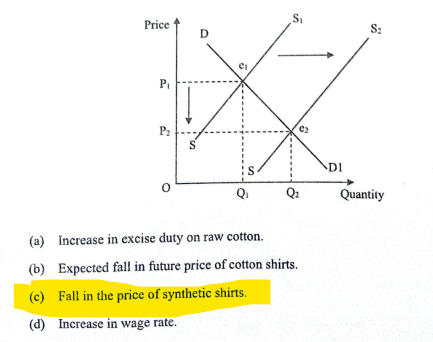
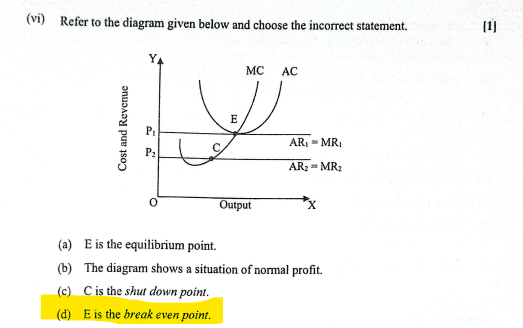
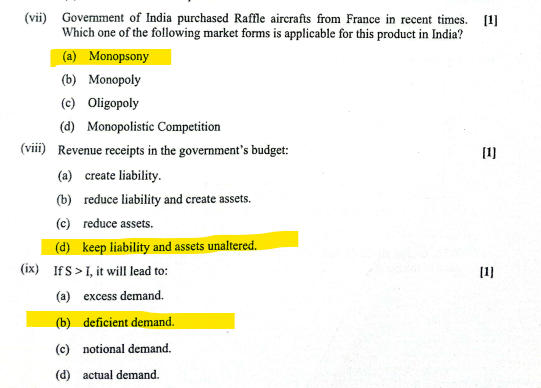
(x) An increase in the number of firms in the market causes a rightward shift in the market supply curve, but the individual supply curve may shift leftward. Justify the statement.
(xi) State whether the following is True or False. Give a reason for your answer. TVC is an avoidable cost.
(xii) Mention any one difference between Induced investment and Autonomous investment.
(xiii) Why is the demand curve for foreign exchange negatively sloped?
(xiv) Mention any one difference between the Balance of Trade and Balance of Payment.
(xv) How is APS obtained from APC?
(xvi) With reference to Simple Keynesian model, give the meaning of ex-ante demand.
Question 2
(i) Milk is used for making curd, sweets and chocolates. What type of demand does milk have? Give a reason.[3]
ii) Figures (A), (B) and (C) given below represent different types of Demand curves.

What kind of goods do each of these Demand curves represent? Give a reason for each of the curves.
Question 3
(i) A huge production of onions and lack of storage facilities have caused a continuous fall in its price. This may adversely affect the production of onions in the subsequent year. With the help of a diagram, briefly explain the measure that the government should adopt to combat this situation.
(ii) Draw and explain Average Fixed Cost curve.
Question 4
With the help of a diagram, explain the relationship between Average Product and Total Product under the Law of Variable Proportions.
Question 5
(1) Briefly discuss the implication of ‘freedom of entry and exit’ under perfect competition.
(ii) Per unit price of electricity is higher in the Commercial sector as compared to the Domestic sector. Identify and briefly describe this phenomenon. Name the market in which it is applicable.
OR
(i) Briefly discuss the importance of Selling Cost under oligopoly market.
(ii) There are many manufacturers of pencils in the market who produce pencils in different designs and colours to attract children. Which market form is referred to here? Briefly explain the feature of this market form indicated in the given situation.
Question 6
(1) What is meant by autonomous consumption expenditure? Show it on a diagram.
(ii) When National Income rises from 600 cr. to 1000 cr., the consumption expenditure increases from 500 cr. to 800 cr. Calculate MPC and hence the value of Investment Multiplier.
Question 7
(1) A large amount of fiscal deficit proves to be counter productive. Give any two reasons in support of this statement.
(ii) What is meant by no quid pro quo of a tax? Name any two direct taxes.
Question 8
(i) Categorise the following items into Current Account or Capital Account of Balance of Payment of India.
(a) Acquisition of land in India by an American firm
(b) Use of transport by Indian tourists in Dubai
(c) Dividend paid to foreigners on their investment in shares in India
(d) Loan taken by India from International Monetary Fund (IMF) to cover its BOP deficit
(ii) Briefly explain the effect of the following on the Balance of Payment of a country.
(a) Inflationary pressure in the economy
(b) Appreciation in domestic exchange rate,
OR
(1) Suppose the exchange rate was $180 and later changed to $192. What will be its effect on the following?
(a) Export of cotton garments by India to the USA
(b) Export of technical knowledge by the USA to India
(c) Import of wheat by India from the USA
(d) Import of gold jewellery by the USA from India
(ii) Briefly discuss the fixed exchange rate system of determining foreign exchange rate
Question 9
Draw a well labelled diagram and explain the circular flow of income in a four-sector model.
SECTION C-32 MARKS
Question 10
(i) How is Total Revenue under perfect competition different from Total Revenue under imperfect competition? Give two points to show the difference.
(ii) Explain the short run equilibrium of a perfectly competitive firm earning supernormal profit with the help of a diagram.
Question 11
(i) Draw a straight-line demand curve joining both the axes. Indicate the following on the demand curve.
(a) Elasticity of demand is equal to zero
(b) Elasticity of demand is greater than one
(ii) Observe the graph given below and answer the questions that follow.

(a) Give a reason to explain if the graph shown above can be a common phenomenon or not.
(b) What is an indifference map? Draw its diagram.
(c) State any two differences between cardinal utility and ordinal utility.
OR
(i) Give two differences between intended supply and actual supply.
(ii) Refer to the diagram given below and answer the questions that follow.

(a) What does the line AB represent? Why is the line AB negatively sloped?
(b) At which one of the given points, D, E and F, will the consumer attain equilibrium? Explain.
(c) Briefly explain why the consumer is not in equilibrium at the other two points.
Question 12
(i) State whether the following items will be included in the estimation of National Income or not? Give a reason for your answer.
(a) Government expenditure on street lighting.
(b) Profit earned by State Bank of India in a foreign country.
(ii) Calculate GNPMP and NNPFC from the following data by Expenditure Method.

(1) State whether the following items will be included in the estimation of National Income or not? Give a reason for your answer.
(a) Fresh tomatoes used by a food processing company.
(b) Wooden cupboard purchased by a family.
(ii) Calculate National Income using Income method and Output method.

Question 13
Read the passage given below and answer the questions that follow.
The Monetary Policy Committee (MPC) increased the repo rate, at which RBI lends short term funds to the commercial banks, from 6-25 percent to 6-50 percent. This increase in repo rate is based on the increase in the key rate by 250 bps. The Committee also decided to continue the withdrawal of money supply in the economy.
[Source (Edited): The Economic Times, Feb. 8, 2023)
(i) Which function of central bank is hinted at, in the passage given above?
(ii) In which situation does central bank adopt the measure given in the above passage?
(iii) Explain any two monetary measures that can be used to accomplish a similar objective, other than the one given in the above passage.
(iv) Differentiate between Reserve Bank of India and Commercial banks by giving any two points.
| ICS Question Papers 2024 |
| ISC Class 12 English Answer Key 2024 PDF for Literature, Language Papers |
|
ISC Class 12 Math Answer Key 2024 PDF, Important Maths Questions
|
Class 12 ISC Economics Answer Key PDF 2024 Link
Students who are taking the paper next year can familiarise themselves with the exam format by reviewing the Class 12 Economics Question Paper 2024. Students know that we can use the ISC Economics answer key 2024 to estimate their marks. Students can use them to determine which questions they properly answered on the exam. Students can find the expert-provided answer key for ISC Economics Paper 2024 using the links provided below.
| ISC Class 12 Economics Question Paper 2024 with Solution |
| ISC Class 12 Economics Answer Key 2024 PDF Link (ACTIVE) |
Important Economics Questions 2024 ISC
Students should revise the entire ISC Economics specimen paper to ensure they have a thorough understanding of all the key concepts covered in the important chapters. Click the link below to view the Class 12 Economics specimen paper.
ISC Economics Specimen Paper 2024, PDF Download Link with Answers
Check out these important economics questions for the ISC Class 12 Economics exam:
- GST has been imposed at the rate of 5% both on edible oil and a few spices. In this situation, the supply curve of edible oil will: [1]
(a) shift leftward.
(b) shift rightward.
(c) not change its position.
(d) slope downward.
- Which type of tax discourages people from making more money as it can lead to class warfare and individuals hiding income or assets? [1]
(a) A small percentage of tax charged on an individual’s income.
(b) A fixed percentage of tax charged on an individual’s income.
(c) Tax charged at a decreasing rate when income of the individual increases.
(d) Tax charged at an increasing rate when income of the individual increases.
- Identify the equilibrium of the firm in the graph given below: [1]

(a) T is the equilibrium point at which firm enjoys supernormal profit.
(b) K is the equilibrium point when firm faces losses.
(c) T is the equilibrium point causing normal profit to the firm.
(d) K indicates equilibrium which reveals zero profit to the producer
- (i) Refer to the graph given below and determine the behaviour of TU as MU decreases up to the point ‘b’. [1]
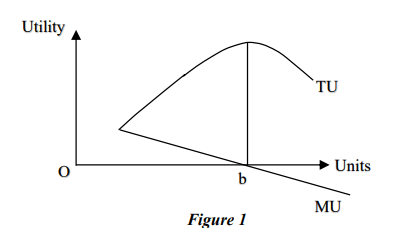 (a) TU increases up to a limit and remains positive.(b) TU increases at an increasing rate(c) TU increases at a diminishing rate.(d) TU is at a point of satiety.
(a) TU increases up to a limit and remains positive.(b) TU increases at an increasing rate(c) TU increases at a diminishing rate.(d) TU is at a point of satiety. - (i) What does the difference between fiscal deficit and interest payments imply? What does ‘zero difference’ mean in this case? [2](ii) In some situations, the government may consider additional spending to fight inflation. Justify this statement. [2]
- (i) What is the difference between Real GDP and Nominal GDP? [2](ii) Calculate National Income by Income Method and Expenditure Method from the following information: [6]
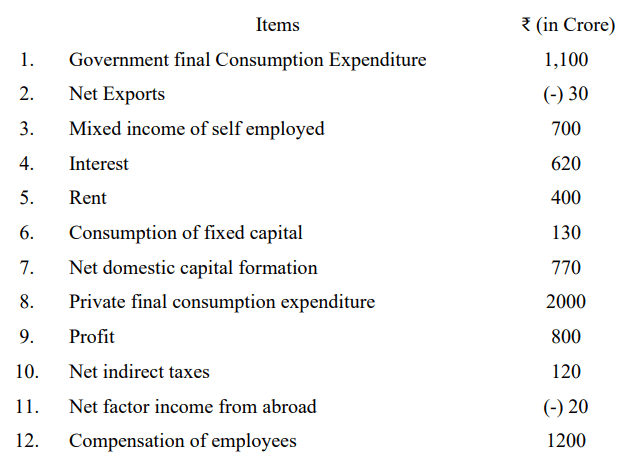
- (ii) Calculate GDPMP and NNPMP from the following data: [6]
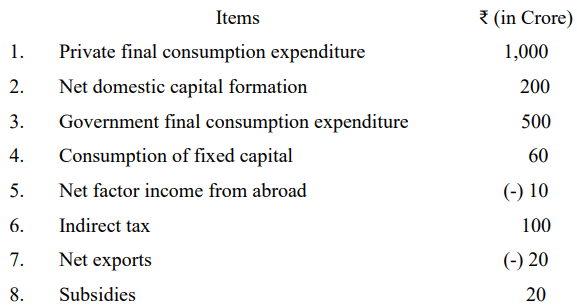

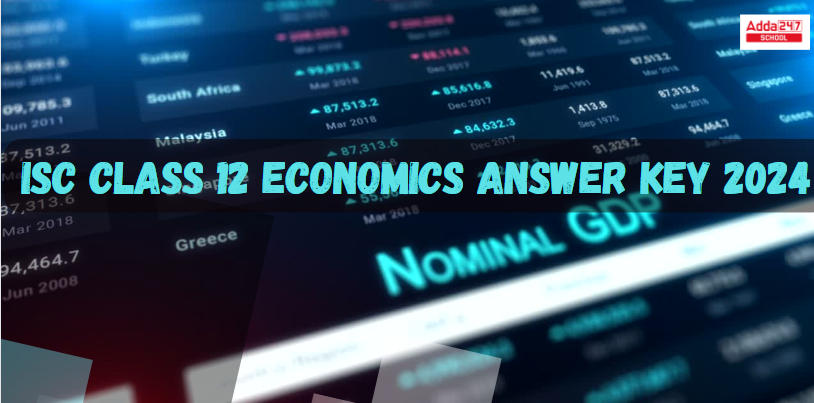



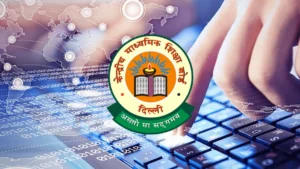 CBSE Class 12 Computer Science Answer Ke...
CBSE Class 12 Computer Science Answer Ke...
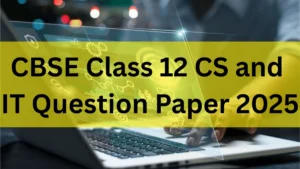 CBSE Class 12 Computer Science Question ...
CBSE Class 12 Computer Science Question ...
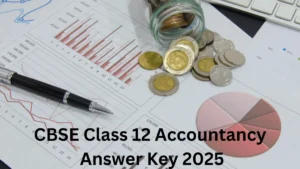 CBSE Class 12 Accountancy Answer Key 202...
CBSE Class 12 Accountancy Answer Key 202...






